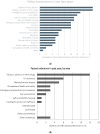The Relationship of Policymaking and Networking Characteristics among Leaders of Large Urban Health Departments
- PMID: 26258784
- PMCID: PMC4555272
- DOI: 10.3390/ijerph120809169
The Relationship of Policymaking and Networking Characteristics among Leaders of Large Urban Health Departments
Abstract
Background: The relationship between policy networks and policy development among local health departments (LHDs) is a growing area of interest to public health practitioners and researchers alike. In this study, we examine policy activity and ties between public health leadership across large urban health departments.
Methods: This study uses data from a national profile of local health departments as well as responses from a survey sent to three staff members (local health official, chief of policy, chief science officer) in each of 16 urban health departments in the United States. Network questions related to frequency of contact with health department personnel in other cities. Using exponential random graph models, network density and centrality were examined, as were patterns of communication among those working on several policy areas using exponential random graph models.
Results: All 16 LHDs were active in communicating about chronic disease as well as about use of alcohol, tobacco, and other drugs (ATOD). Connectedness was highest among local health officials (density = .55), and slightly lower for chief science officers (d = .33) and chiefs of policy (d = .29). After accounting for organizational characteristics, policy homophily (i.e., when two network members match on a single characteristic) and tenure were the most significant predictors of formation of network ties.
Conclusion: Networking across health departments has the potential for accelerating the adoption of public health policies. This study suggests similar policy interests and formation of connections among senior leadership can potentially drive greater connectedness among other staff.
Keywords: big cities health coalition; network research; policy networks; public health systems; urban health.
Figures


Similar articles
-
Multisector Health Policy Networks in 15 Large US Cities.J Public Health Manag Pract. 2016 Nov-Dec;22(6):520-8. doi: 10.1097/PHH.0000000000000401. J Public Health Manag Pract. 2016. PMID: 26910868 Free PMC article.
-
The future of urban health: needs, barriers, opportunities, and policy advancement at large urban health departments.J Public Health Manag Pract. 2015 Jan-Feb;21 Suppl 1(Suppl 1):S4-13. doi: 10.1097/PHH.0000000000000166. J Public Health Manag Pract. 2015. PMID: 25423056 Free PMC article.
-
Communication ties across the national network of local health departments.Am J Prev Med. 2013 Mar;44(3):247-53. doi: 10.1016/j.amepre.2012.10.028. Am J Prev Med. 2013. PMID: 23415121
-
Evidence-Informed Planning for Healthy Liveable Cities: How Can Policy Frameworks Be Used to Strengthen Research Translation?Curr Environ Health Rep. 2019 Sep;6(3):127-136. doi: 10.1007/s40572-019-00236-6. Curr Environ Health Rep. 2019. PMID: 31134515 Review.
-
Reason and protest in the new urban public health movement: an observation on the sociological analysis of political discourse in the 'healthy city'.Br J Sociol. 1996 Dec;47(4):657-70. Br J Sociol. 1996. PMID: 9011316 Review.
Cited by
-
Systems Thinking and Complexity Science Methods and the Policy Process in Non-communicable Disease Prevention: A Systematic Scoping Review.Int J Health Policy Manag. 2023;12:6772. doi: 10.34172/ijhpm.2023.6772. Epub 2023 Feb 26. Int J Health Policy Manag. 2023. PMID: 37579437 Free PMC article.
-
Mapping Collaborative Relations among Canada's Chronic Disease Prevention Organizations.Healthc Policy. 2016 Aug;12(1):101-15. Healthc Policy. 2016. PMID: 27585030 Free PMC article.
-
Multisector Health Policy Networks in 15 Large US Cities.J Public Health Manag Pract. 2016 Nov-Dec;22(6):520-8. doi: 10.1097/PHH.0000000000000401. J Public Health Manag Pract. 2016. PMID: 26910868 Free PMC article.
References
-
- The Public Health System and the 10 Essential Public Health Services. [(accessed on 16 June 2015)]; Available online: http://www.cdc.gov/nphpsp/essentialServices.html.
-
- Satterfield D.W., Murphy D., Essien J.D., Hosey G., Stankus M., Hoffman P., Beartusk K., Mitchell P.L., Alfaro Correa A. Using the essential public health services as strategic leverage to strengthen the public health response to diabetes. Public Health Rep. 2004;119:311–321. doi: 10.1016/j.phr.2004.04.010. - DOI - PMC - PubMed
-
- 2013 National Profile of Local Health Departments. [(accessed on 16 June 2015)]. Available online: http://www.naccho.org/topics/infrastructure/profile/upload/2013-National....
Publication types
MeSH terms
LinkOut - more resources
Full Text Sources
Other Literature Sources

